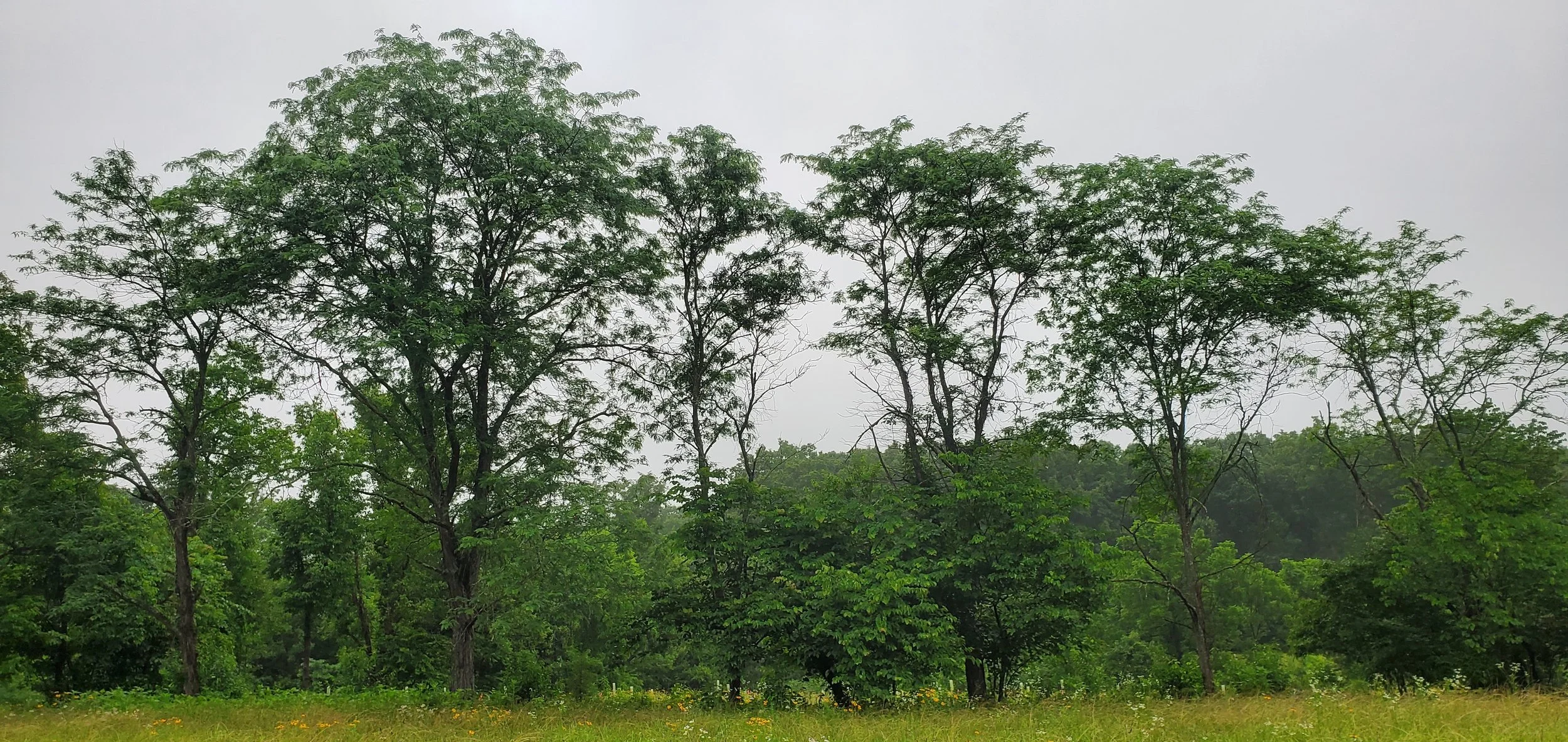 Image 1 of 9
Image 1 of 9

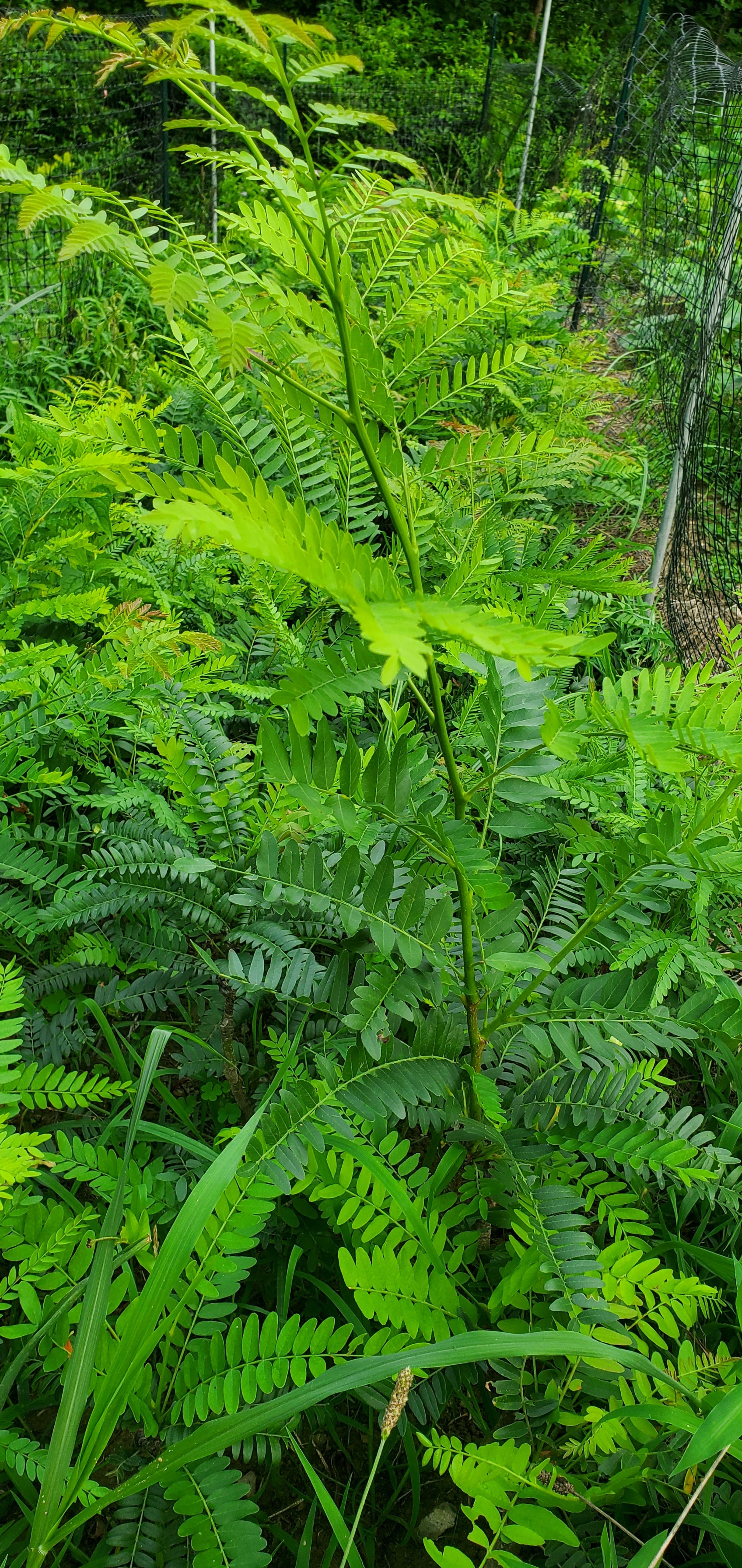 Image 2 of 9
Image 2 of 9

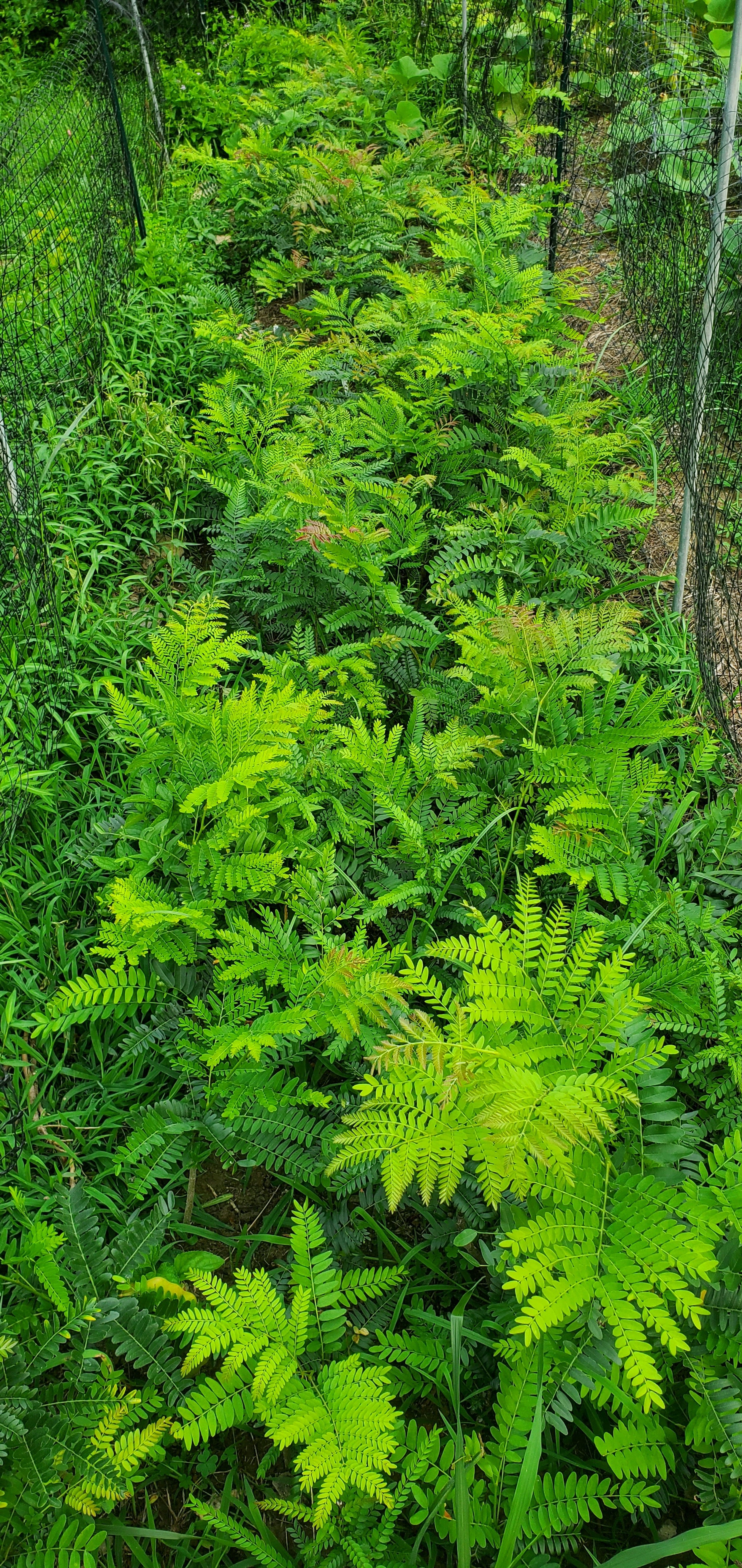 Image 3 of 9
Image 3 of 9

 Image 4 of 9
Image 4 of 9

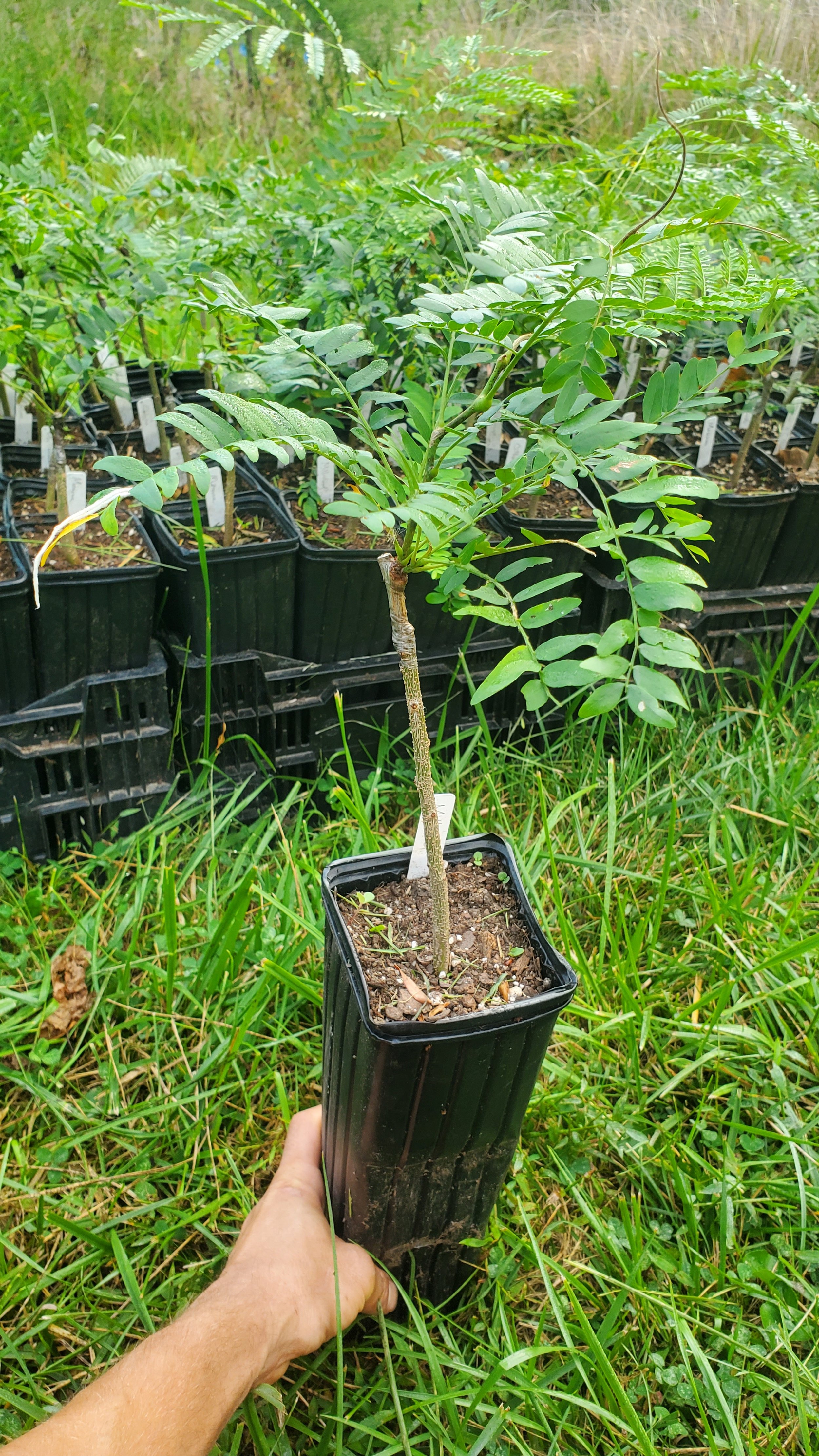 Image 5 of 9
Image 5 of 9

 Image 6 of 9
Image 6 of 9

 Image 7 of 9
Image 7 of 9

 Image 8 of 9
Image 8 of 9

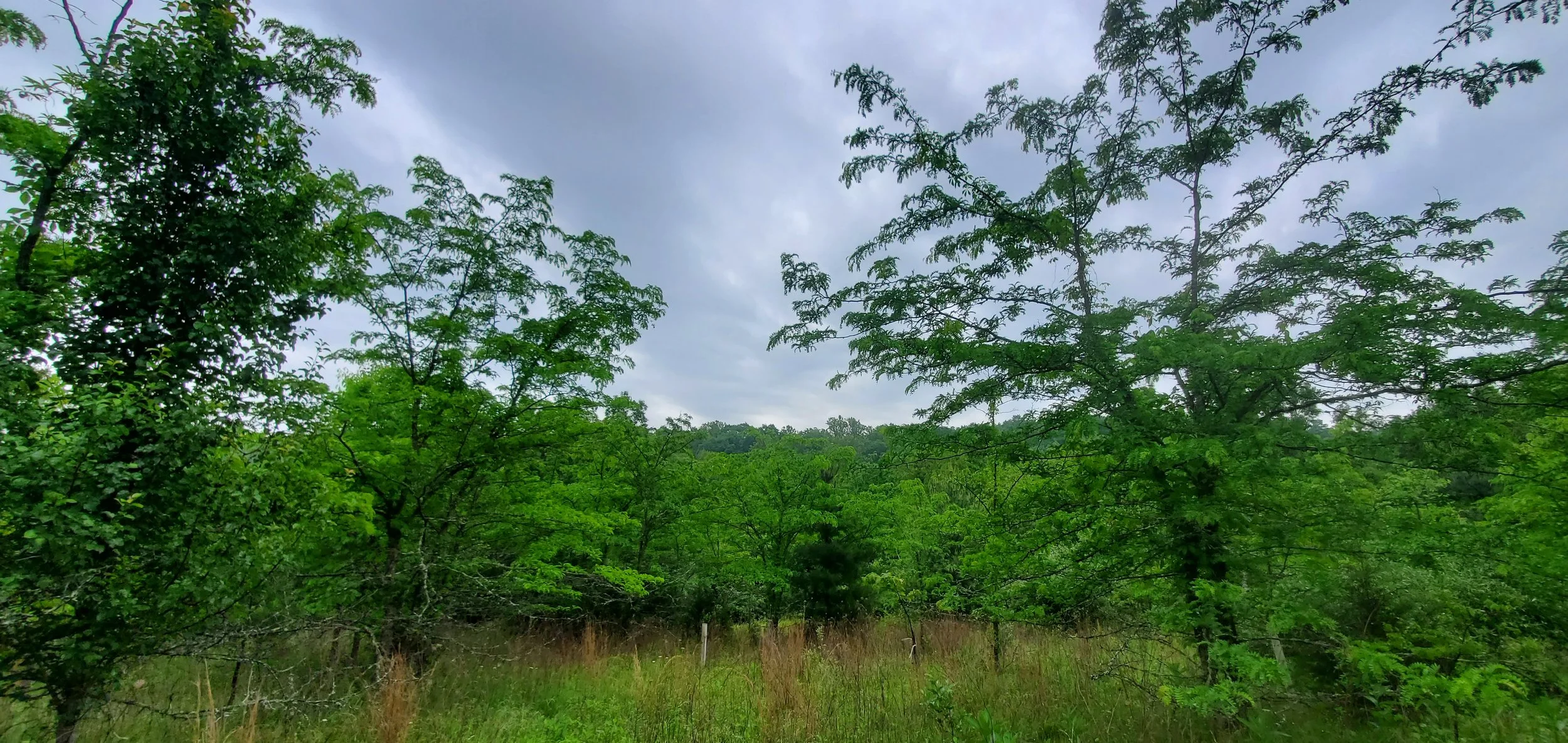 Image 9 of 9
Image 9 of 9










Grafted Honey Locust
Honey locusts are beautiful trees with patterned grey bark, lightly twisting forms, and small pinnate compound leaves casting a dappled shade. While often planted as street trees, the following selections listed here are for fleshy pod production for agroforestry applications.
The inner flesh of the honey locust turns from green to an amber honey-colored sugary goo when ripe. Eaten raw, the honey locust flesh has a flavor ranging from rather like spicy apple cider, through to mellower melon tones. The seeds in the pods are a rich source of protein and have a complete amino acid profile.
Like maple sugaring in the north, Native Americans used the pods as a southern sugar tree. The pods can be dried and ground to make a carob-like powder excellent for baking as a sweetener. Honey locusts are desirable for silvopasture, where during the summer months the dappled shade promotes cool season forage grasses, and in the winter the pods provide sugar and protein rich fodder during an otherwise lean time.
Honey locusts are polygamodioecious, often bearing separate male and female flowers on the same tree. They are also parthenocarpic, so they will produce pods even without a pollinizer, the same ways hens will still lay without a rooster.
Honey locusts can also bear thorns. These are quite gnarly, being so large as to have their own branches — thorns upon thorns! The honey locust emerged millions of years ago, during a period in Earth’s history when the trees evolved these defenses on their trunk to guard from foraging mastodons. Fortunately, since the demise of the mastodon, and further selection by humans, many honey locusts are entirely thornless.
Thorniness may be plotted on a continuum from 1 to 10 (1 being entirely thornless and 10 being horribly thorned). Because the following trees are grafted, they will all grow thornless anyhow, but I have made it a point to describe whether the original tree they came from was thornless or not. This issue is important if you want thornless progeny to one day grow from your honey locust trees. Genetically thornless trees tend to thornless offspring, and as a breeder, or silvopasture manager, you need to know!
Grafted honey locust trees ship in 4” x 14” tree pots for $40 or bareroot for $35.
Andy (aka “SpringTree A”) — new 2025 introduction from the SpringTree plantings in Virginia. I’ve been working with Andy Wilson there inventorying, evaluating, and selecting from the vast feral repository of honey locust he has overseen. This is a tree which is entirely thornless, the pods are tested at 34% sugar, and the tree appears to be strongly annually bearing, having had a good crop in 2024 and now again in 2025. That is the trifecta of good traits. I named it Andy in his honor.
Ashworth – a northern selection by Bill MacKentley and Fred L. Ashworth of St. Lawrence Nursery, Potsdam, NY, circa mid-1970s. Very sweet pods said to taste like melon, but not as fleshy as TVA selections Millwood and Calhoun. Original tree from planting at Potsdam College in New York state in zone 3b/4a, so this is good for northern plantings colder than zone 6.
*Big Fatty – when Buzz Ferver pronounced this name for the fleshiest podded tree I had found through my inventory of honey locusts at John Hershey’s farm, the name stuck. At the time we did not have reference samples for the old TVA selections. Now we do. I’ve since determined that Big Fattyis Calhoun, and so I can’t offer this selection under this name anymore in good conscience.
Calhoun – introduced through John Hershey's work at the TVA. Pods 38% sugar by weight. Tree bears most years, semi-annually. Zone 6b and warmer. The original tree was moderately thorny.
Chiaha – my 2023 selection from Tennessee. Named for the Native village of the Koasati and later Cherokee which once stood where this tree was found. The pods are among the fleshiest I've seen - though test results await. Original tree is moderately thorny but grafts will be thornless.
Colley — selection from Hopkinsville, KY. I noticed the tree and Lucky Pittman was kind enough to shoot down and send me the scion from this tall, old tree. Ortet entirely thornless, pods look promising, but awaits further evaluation. Introduced 2023.
Cooper – fleshy podded selection from Taylor Malone in Tennessee. Original tree was nearly thornless.
Hershey – named after John Hershey, who introduced the classic TVA honey locust selections in the ‘30s such as Millwood and Calhoun. Said to bear 16 pods to the pound. Heavy bearer. I have not been able to trace more of the history of this particular variety than this. I don’t know if it’s a selection Hershey bred himself, or if it was later named in his honor from out of his plantings.
Lancaster North — introduced by Alex Tanke 2022, seed from Lancaster county PA. Original tree is thorny bearing promising pods with very wide pericarps. Needs further evaluation.
Leisczs Bridge — mildly thorny / mostly thornless annual-bearing honey locust with somewhat fleshy pods, probably around 25% sugar but untested. From the Reading, PA area. For breeding purposes.
Marguerite – This variety introduced by Hector Black of Hidden Springs Nursery in TN. A solid, fleshy-podded variety. Original tree was thornless or mostly so.
Millwood – a Tennessee Valley Authority (TVA) selection first introduced by John Hershey from a tree found near Lake Junaluska, North Carolina. This variety has been extensively field tested in Virginia for silvopasture as a cattle feed. 31% sugar by weight and 13% protein. Original tree was entirely thornless.
Monroe – introduced by Alex Tanke and myself 2022. Tested at 35% sugar by weight, comparable to the best TVA selections. From Monroe county Arkansas and the original tree is entirely thornless. Performs well in zones 5b/6a! Good for more northern plantings.
Piatt – another selection from Alex Tanke and myself. This fleshy podded variety comes originally from Piatt county, Illinois and is tested for zone 6a, so can be recommended for the north.
Poole Forge – an Austin Unruh of Trees for Graziers selection from Narvon, PA. Original tree is entirely thornless and tested at 28% sugar. Sadly, the ortet was cut down and herbicided in winter 2025.
Reiff — selection from Ewing, Virginia sent me by Laura Reiff. Original tree is moderately thorny and pods fleshy and promising, but yet to be tested for sugar %. Introduced 2025.
Richland – promising fleshy-podded selection from Tennessee. Original tree moderately thorny and pods very fleshy. Introduced 2024, untested.
Schofer – named for Richard Schofer, who found the original tree near Pennsburg, PA. Schofer operated a bakery in Reading, PA where he had a honey locust orchard he planted to supply the bakery. John Hershey and J. Russell Smith introduced Schofer into their later catalogs, describing it as a fleshy honey locust which solved the hardiness problem for the north. Original tree was thornless or nearly so. Somewhat annually bearing. I’m pleased to be able to offer this variety again into the trade.
SpringTree selections A-Z —
A (aka Andy): 34% sugar, thornless, annually-bearing.
F: 31.5% sugar, thornless.
H: 31% sugar, thornless, annually-bearing.
K: very high sugar % but not yet lab tested, thorny, and annually-bearing after the manner of Calhoun, of which this is presumably a seedling.
Trotter Experimental Series – untested selections from Tennessee which I made in the field in 2023 based upon pod fleshiness. Ortet trees labeled as thornless or thorny for breeding purposes, but all grafts will grow thornless.
Honey locusts are beautiful trees with patterned grey bark, lightly twisting forms, and small pinnate compound leaves casting a dappled shade. While often planted as street trees, the following selections listed here are for fleshy pod production for agroforestry applications.
The inner flesh of the honey locust turns from green to an amber honey-colored sugary goo when ripe. Eaten raw, the honey locust flesh has a flavor ranging from rather like spicy apple cider, through to mellower melon tones. The seeds in the pods are a rich source of protein and have a complete amino acid profile.
Like maple sugaring in the north, Native Americans used the pods as a southern sugar tree. The pods can be dried and ground to make a carob-like powder excellent for baking as a sweetener. Honey locusts are desirable for silvopasture, where during the summer months the dappled shade promotes cool season forage grasses, and in the winter the pods provide sugar and protein rich fodder during an otherwise lean time.
Honey locusts are polygamodioecious, often bearing separate male and female flowers on the same tree. They are also parthenocarpic, so they will produce pods even without a pollinizer, the same ways hens will still lay without a rooster.
Honey locusts can also bear thorns. These are quite gnarly, being so large as to have their own branches — thorns upon thorns! The honey locust emerged millions of years ago, during a period in Earth’s history when the trees evolved these defenses on their trunk to guard from foraging mastodons. Fortunately, since the demise of the mastodon, and further selection by humans, many honey locusts are entirely thornless.
Thorniness may be plotted on a continuum from 1 to 10 (1 being entirely thornless and 10 being horribly thorned). Because the following trees are grafted, they will all grow thornless anyhow, but I have made it a point to describe whether the original tree they came from was thornless or not. This issue is important if you want thornless progeny to one day grow from your honey locust trees. Genetically thornless trees tend to thornless offspring, and as a breeder, or silvopasture manager, you need to know!
Grafted honey locust trees ship in 4” x 14” tree pots for $40 or bareroot for $35.
Andy (aka “SpringTree A”) — new 2025 introduction from the SpringTree plantings in Virginia. I’ve been working with Andy Wilson there inventorying, evaluating, and selecting from the vast feral repository of honey locust he has overseen. This is a tree which is entirely thornless, the pods are tested at 34% sugar, and the tree appears to be strongly annually bearing, having had a good crop in 2024 and now again in 2025. That is the trifecta of good traits. I named it Andy in his honor.
Ashworth – a northern selection by Bill MacKentley and Fred L. Ashworth of St. Lawrence Nursery, Potsdam, NY, circa mid-1970s. Very sweet pods said to taste like melon, but not as fleshy as TVA selections Millwood and Calhoun. Original tree from planting at Potsdam College in New York state in zone 3b/4a, so this is good for northern plantings colder than zone 6.
*Big Fatty – when Buzz Ferver pronounced this name for the fleshiest podded tree I had found through my inventory of honey locusts at John Hershey’s farm, the name stuck. At the time we did not have reference samples for the old TVA selections. Now we do. I’ve since determined that Big Fattyis Calhoun, and so I can’t offer this selection under this name anymore in good conscience.
Calhoun – introduced through John Hershey's work at the TVA. Pods 38% sugar by weight. Tree bears most years, semi-annually. Zone 6b and warmer. The original tree was moderately thorny.
Chiaha – my 2023 selection from Tennessee. Named for the Native village of the Koasati and later Cherokee which once stood where this tree was found. The pods are among the fleshiest I've seen - though test results await. Original tree is moderately thorny but grafts will be thornless.
Colley — selection from Hopkinsville, KY. I noticed the tree and Lucky Pittman was kind enough to shoot down and send me the scion from this tall, old tree. Ortet entirely thornless, pods look promising, but awaits further evaluation. Introduced 2023.
Cooper – fleshy podded selection from Taylor Malone in Tennessee. Original tree was nearly thornless.
Hershey – named after John Hershey, who introduced the classic TVA honey locust selections in the ‘30s such as Millwood and Calhoun. Said to bear 16 pods to the pound. Heavy bearer. I have not been able to trace more of the history of this particular variety than this. I don’t know if it’s a selection Hershey bred himself, or if it was later named in his honor from out of his plantings.
Lancaster North — introduced by Alex Tanke 2022, seed from Lancaster county PA. Original tree is thorny bearing promising pods with very wide pericarps. Needs further evaluation.
Leisczs Bridge — mildly thorny / mostly thornless annual-bearing honey locust with somewhat fleshy pods, probably around 25% sugar but untested. From the Reading, PA area. For breeding purposes.
Marguerite – This variety introduced by Hector Black of Hidden Springs Nursery in TN. A solid, fleshy-podded variety. Original tree was thornless or mostly so.
Millwood – a Tennessee Valley Authority (TVA) selection first introduced by John Hershey from a tree found near Lake Junaluska, North Carolina. This variety has been extensively field tested in Virginia for silvopasture as a cattle feed. 31% sugar by weight and 13% protein. Original tree was entirely thornless.
Monroe – introduced by Alex Tanke and myself 2022. Tested at 35% sugar by weight, comparable to the best TVA selections. From Monroe county Arkansas and the original tree is entirely thornless. Performs well in zones 5b/6a! Good for more northern plantings.
Piatt – another selection from Alex Tanke and myself. This fleshy podded variety comes originally from Piatt county, Illinois and is tested for zone 6a, so can be recommended for the north.
Poole Forge – an Austin Unruh of Trees for Graziers selection from Narvon, PA. Original tree is entirely thornless and tested at 28% sugar. Sadly, the ortet was cut down and herbicided in winter 2025.
Reiff — selection from Ewing, Virginia sent me by Laura Reiff. Original tree is moderately thorny and pods fleshy and promising, but yet to be tested for sugar %. Introduced 2025.
Richland – promising fleshy-podded selection from Tennessee. Original tree moderately thorny and pods very fleshy. Introduced 2024, untested.
Schofer – named for Richard Schofer, who found the original tree near Pennsburg, PA. Schofer operated a bakery in Reading, PA where he had a honey locust orchard he planted to supply the bakery. John Hershey and J. Russell Smith introduced Schofer into their later catalogs, describing it as a fleshy honey locust which solved the hardiness problem for the north. Original tree was thornless or nearly so. Somewhat annually bearing. I’m pleased to be able to offer this variety again into the trade.
SpringTree selections A-Z —
A (aka Andy): 34% sugar, thornless, annually-bearing.
F: 31.5% sugar, thornless.
H: 31% sugar, thornless, annually-bearing.
K: very high sugar % but not yet lab tested, thorny, and annually-bearing after the manner of Calhoun, of which this is presumably a seedling.
Trotter Experimental Series – untested selections from Tennessee which I made in the field in 2023 based upon pod fleshiness. Ortet trees labeled as thornless or thorny for breeding purposes, but all grafts will grow thornless.